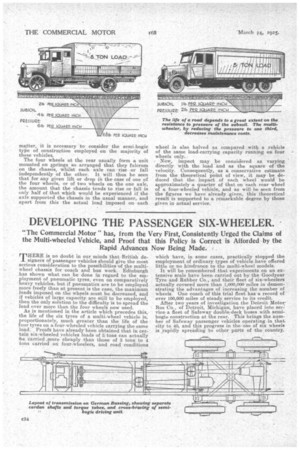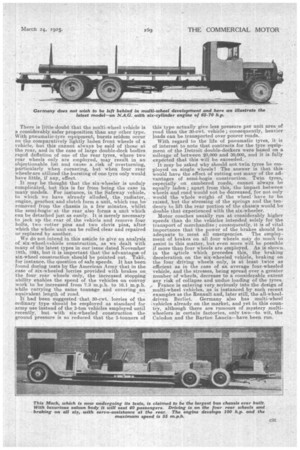DEVELOPING THE PASSENGER SIX-WHEELER.
Page 18

Page 19

If you've noticed an error in this article please click here to report it so we can fix it.
"The Commercial Motor" has, from the Very First, Consistently Urged the Claims of the Multi-wheeled Vehicle, and Proof that this Policy is Correct is Afforded by the
Rapid Advances Now Being Made. T.
HERE is no doubt in our minds that British de signers of passenger vehicles should give the most serious consideration to the possibilities of the multiwheel chassis for coach and bus work. Edinburgh has shown what can be done in regard to the employment of pneumatic tyres, even on comparatively heavy vehicles, but if pneumatics are to be employed more freely than at present is the case, the maximum loads imposed on the wheels must be decreased, and if vehicles of large capacity are still to be employed, then the only solution to the difficulty is to spread the load over more than the four wheels now used.
As is mentioned in the article which precedes this,the life of the six tyres of a multi-wheel vehicle is, proportionately, much greater than the life of the four tyres on a-four-wheeled vehicle carrying the same load. Proofs have already been obtained that in certain six-wheeled vehicles loads of ktons can actually be Carried more cheaply than those of 3 tons to 4 tons carried on four-wheelers, and road conditions which have, in some cases, practically stopped the employment of ordinary types of vehicle have offered little or no hindrance to the multi-wheel models. It will be remembered that experiments on an extensive scale have been carried out by the Goodyear Tyre and Rubber Co., and their fleet of six-wheelers actually covered more than E,000,000 miles in demonstrating the advantages of increasing the number of wheels. One coach of this trial fleet has a record of over 100,000 miles of steady service to its credit.
After two years of investigation the Detroit Motor" Bus Co., of betroit, Michigan, have placed into ser2 vice a fleet of Safeway double-deck buses with semibogie construction at the rear. This brings the number of Safeway passenger vehicles operating in that. city to 40, and this progress in the use of six wheels is rapidly spreading to other parts of the country. There is little ,doubt that the multi-wheel vehicle is a considerably safer proposition than any other type. With pneumatic-tyre eluipment, bursts seldom occur on the comparatively lightly laden front wheels of a vehicle, but this cannot always be said of those at the rear, and in the case of large double-deck bodies rapid deflation of one of the rear tyres, where two roar wheels only are employed, may result in an objectionable list and cause a .risk of• overturning, particularly -1rvhen cornering, but when four rear wheelware utilized the bursting of one tyre only would
have .little, if any, effect. .
It may be thought that the six-wheeler is unduly complicated, but this is far from being the case in many models. For instance, in the Safeway vehicle, to which we have already alluded, the radiator,. . engine, gearbox and clutch form a unit, which can be removed frofl the chassis in a few minutes, whilst the semi-bogie at the rear also forms a unit which can he detached just as easily. It is merely necessary to jack Up the rear of, the vehicle and remove four bolts, two cotter pins and two clevis pins, after which the whole unit can be rolled clear and repaired or replaced by another.
We do not intend in this article to give an analysis of six-wheel-vehicle construction, as we dealt with many of the latest types in our issue dated November 18th, 1924, but it is important that the advantage& of six-wheel construction should be pointed out Tale, for instance, the question of safe speeds. It has been found during tests by the American Army that in the case of six-wheeled lorries provided with brakes on the four rear wheels only, the increased stopping ability enables the speed of the vehicles on convoy work to be increased from 7.3 m.p.h. to 16.1 m.p.h. While carrying the mine tonnage and covering an equivalent length of road.
It had been suggested that 30-cwt, lorries of the ordinary type should be employed as standard for army use instead of the 3-ton vehicles employed until recently, but with six-wheeled construction the ground pressure is so reduced that the 5-tonners of this type actually give less pressure per unit area of road than the 30-ewt. vehicle ; consequently, heavier loads can be transported over poorer roads. With regard to the life of pneumatic tyres, it is of interest to note that contracts for the tyre equipment of the Detroit double-deckers were based on a mileage of between 20,000 and 30,000, and it is fully expected that this will be exceeded.
it may be asked why should not twin tyres be employed on single wheels'? The answer is that this would have the effect of cutting out many of the advantages of semi-bogie construction. Twin tyres, especially on cambered roads, cannot always he equally laden ; apart from this, the impact between wheels and road would not be decreased, for not only would the whole weight of the wheel have to be raised, but the stressing of the springs and the tendency to lift the rear portion of the chassis would be double that experienced with the six-wheeler. Motor coaches usually run at considerably higher speeds than do the vehicles intended solely for the transport of merchandise ; consequently, it is of vital importance that the power of the brakes should be adequate to meet all emergencies. The employment of brakes on all four wheels may do much to assist in this matter, but even more will be possible if more than four wheels are employed. As is shown in the axtiele which preeedes this, the braking deceleration on the six-wheeled vehicle, braking on the four driving wheels only, is at least twice as efficient as in the ease of an average four-wheeled vehicle, and the stresses, being spread over a greater number of wheels, decrease to a considerable extent any risk of collapse and undue loading of the tyres. France is entering very. seriously into the design of .multi-wheel vehicles, as is instanced by such recent examples as the Renault and, later still, the all-wheeldriven Berliet. Germany also has multi-wheel vehicles already on the market, and yet in this country, although there are rumours of mystery multiwheelers in certain factories, only two—to wit, the Caledon and the Barton Lancia—have been run.
























































